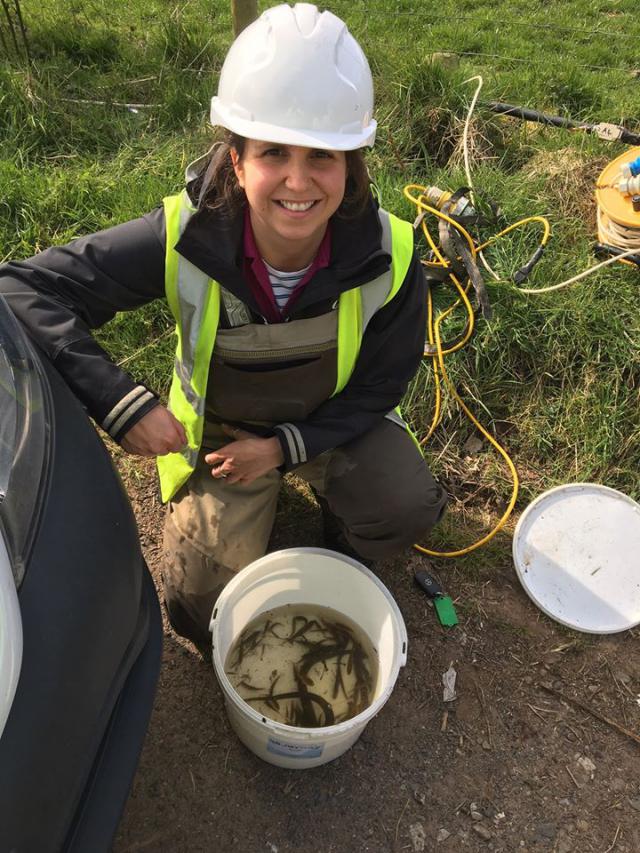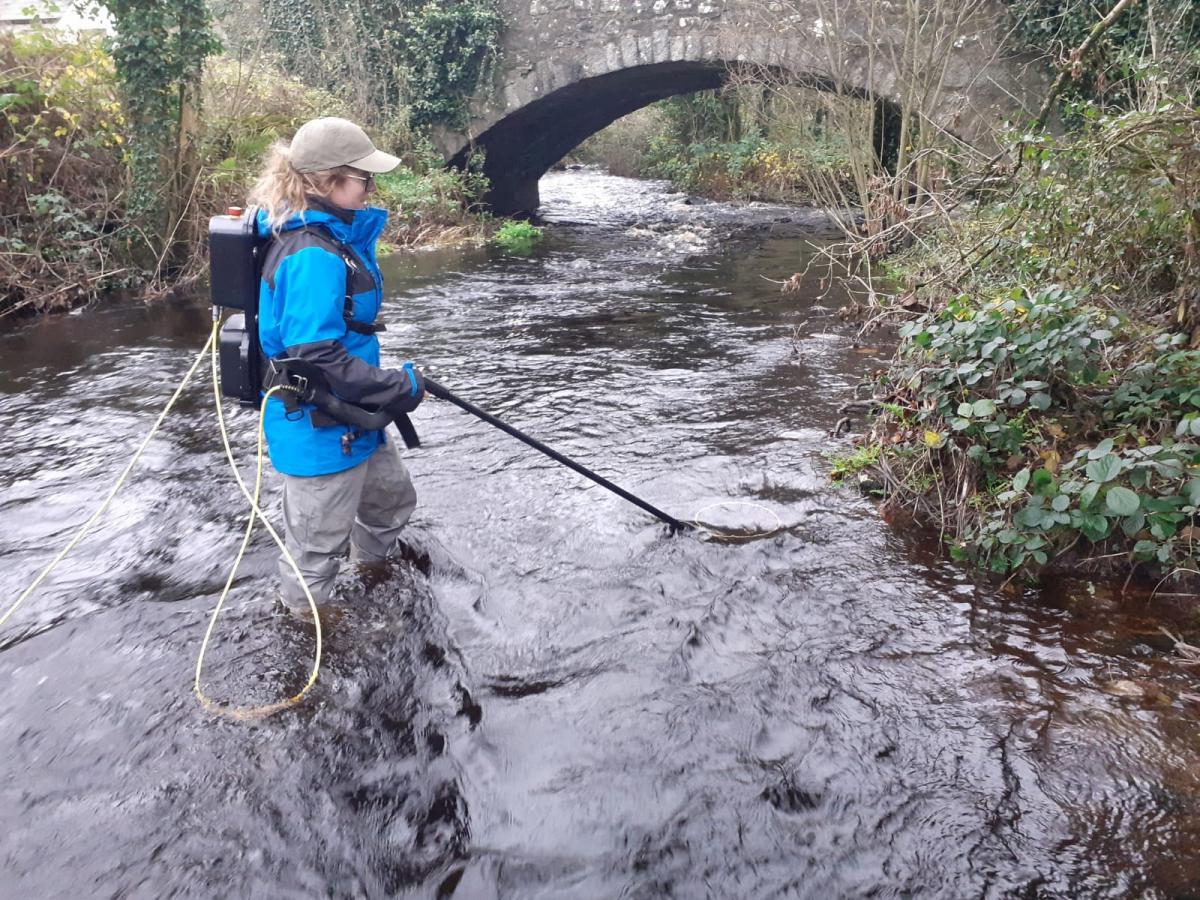Fisheries internship New Year update

19th Jan 2021
by Victoria Semple
Happy New Year! Fisheries intern Abbie here again to give you an update on what I have been doing with GFT over the last few months.
Recently I have been acclimatising to life in Galloway during the colder season, still out completing various fieldwork tasks but wrapping up warm! In my last blog (here), I talked about getting used to GFTs electrofishing and habitat surveying methods, since then I have continued to join electrofishing teams and really honed my skills, including finally being able to distinguish between salmon and trout juveniles! (most of the time).
I have also been getting involved in a process that was completely new to me, working in a salmon hatchery. An Atlantic salmon hatchery is used as part of a targeted stocking program in the upper Bladnoch catchment. The Bladnoch is a Special Area of Conservation (SAC) for Atlantic salmon, however, impacts of acidification have reduced their distribution in the headwaters. Although the upper reaches still suffer with low pH, GFT have found improvements to water quality in some areas where salmon have been absent for many years. To assist in the return of Atlantic salmon to these areas of the upper Tarf, GFT and the Bladnoch DSFB have collected about 63,000 eggs from locally caught wild broodstock for the stocking programme.
So far in the process, broodstock have been caught by anglers using rod and line and brought to GFT’s hatchery. Here we conducted health and weight checks to ensure all fish were suitable broodstock and estimate potential egg numbers. These early days were my first experience of seeing and handling live adult salmon, they are quite remarkable beings to behold. The next stage was to monitor the females until they were ready to be stripped, once ready, the stripping process was carried out by using slight pressure to push the loose eggs out of the body cavity. A similar action was then conducted on the males to release milt into the eggs fertilising them. The milt and egg mixture was left for a short time to fertilise the eggs and then the milt was rinsed off to avoid the eggs sticking together. The volume of the eggs was measured to estimate the total number and then they were carefully placed in trays within the hatchery to develop. This process was completed over a few days in December as not all of the hens were ready at the same time. From here, the eggs have been left to develop and are checked regularly and any dead eggs removed.
To minimise any potential negative impacts from the hatchery processes, it is advised to stock out the fish at an early life stage to help keep the fish as wild as possible. It is planned to return these fish to the Tarf over the next 2 months as eyed eggs placed into artificial redds or as un-fed fry. This will enable these fish to develop passed the very sensitive life stages most susceptible to low pH levels before being returned to the wild.
Research shows some problems associated with stocking programmes which may overall potentially reduce the health and numbers of fish in both the short and long term. However, hatcheries can be a useful tool in some types of fisheries management, such as this, where the natural population has become critically low in the headwaters. This is the basis of all of the stocking which GFT is now involved in especially where acidification has devastated the natural fish populations through poor egg survival. GFT chose specific stocking locations where water quality has now improved to a level that introduced fish can survive. For more info on this project see our update from 2019’s similar stocking program (here).
Seeing this process and learning more about the pros and cons of stocking has been very interesting, I am looking forward to seeing the next stages to come.
Aside from work at the hatchery, I have been focusing on some of my own projects. One of which is the development of an education program based on the critically endangered European eel. The aim of the project is to teach school students about the life of the elusive European eel, the threats they face, and what we can do to support their conservation. Due to the current pandemic, I have been taking a different approach to prior GFT education projects and have been developing sessions that can take place virtually. This will enable me to work with classes without having to make multiple visits into schools within the local area and minimise risk. Creating a virtual program is not without its challenges and there will no doubt be more to come when the sessions take place, but it has been a great opportunity to move with the times and rise to the challenge of educating during the pandemic. I am very much looking forward to rolling out these sessions when schools return.
Since my last post I have also had the opportunity to undertake some training courses. One being First Aid at Work, a very important course for any working environment but this particular course included working within a forestry setting, which is crucial for carrying out many tasks with GFT. In addition, I have undertaken a course to gain a licence for drone flying. Drones are becoming increasingly useful for conservation and ecology, this qualification will give me the opportunity to fly drones for research purposes, increasing my bank of sampling techniques. The opportunity to attend training courses and gain qualifications throughout my internship, is fantastic both to increase my capabilities for working within the team at GFT but also to boost my skillset and support future career aspirations.
I am now coming into the last couple of months of my internship and I have gained so much from this opportunity already. I am looking forward to what these last months will entail and feeling positive that these experiences will stand me in good stead for the future. Once again, thank you to GFT, Galloway Glens and the Holywood Trust for this opportunity.
Latest News
5 year post available with GFT
Galloway Fisheries Trust have an exciting opportunity for a recent graduate. We are able to offer a 5 year post to deliver the 'Kirkcudbrightshire Dee European Eel Study and Restoration Project'.
King of fish secures win for junior angler
For the second year running, a junior angler has secured "Best Fish" at our annual Kirkcowan Angling Competition, which finally got underway on Saturday 27th September
Why do GFT go electrofishing.
Electrofishing is an effective and safe technique used to catch juvenile fish in freshwater habitats.
